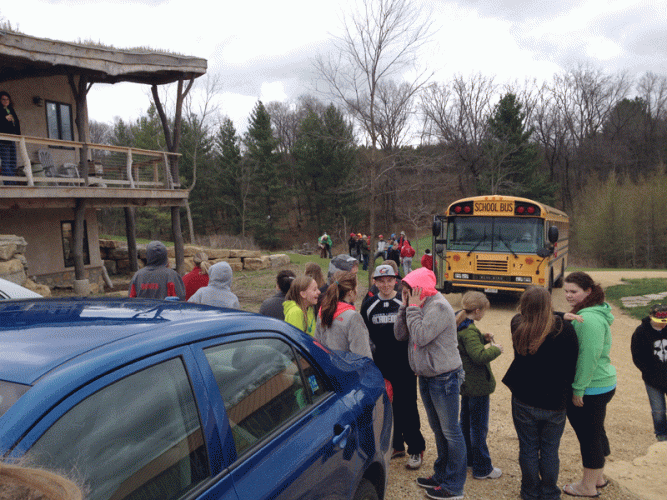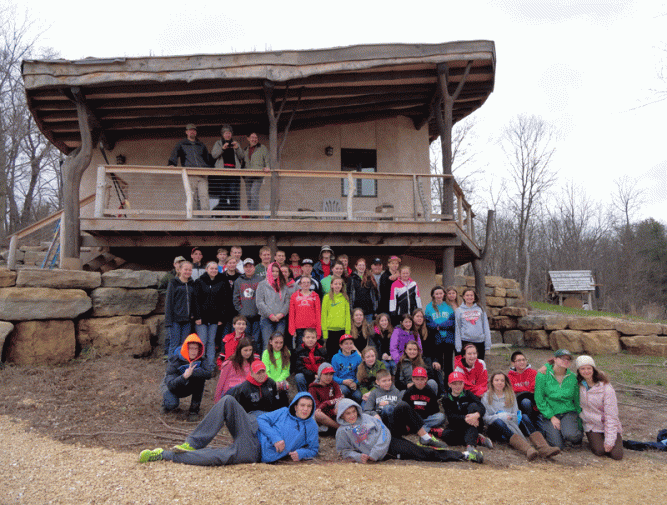We hosted Highland Middle School’s 60 students for a tour of Underhill House last Friday. Highland is a nearby village with 842 residents, and its school system is pushing the environmental education envelope.
“We wrote a grant to start a charter school for 20 students interested in sustainable practices,” says Highland teacher Julie Tess. “When we got the grant, we realized we could convert our entire middle school to this program. It has been charter for four years, and the high school and elementary schools have been charter for three years.”
“Because we converted the entire school, we had to broaden our focus from exclusively environmental to project-based, place-based learning, but a lot of the time we look like an environmental school because of our many environmental projects,” she continued. “Being located on the edge of town, we have a prairie, a pond and a woods to work with. We get a weekly visit from a field biologist, and we are always talking about sustainable practices and an appreciation for the land.”
“Five years ago before we started place-based studies, I don’t think the kids had a clue,” she continued. “It was a while before they realized that being outside was a valuable learning opportunity. Not just recess but an open-air classroom. ”

Bryan Dalstrom explains sustainable construction.
We built Underhill House to serve as a laboratory and example that will help people understand non-conventional, more sustainable ways of building. Last Friday it became a middle school classroom. These 6th, 7th and 8th graders will be making shelter decisions in their future, and I hope their visit has planted some seeds about how to build sustainably.
We hosted half the students in the morning and the other half in the afternoon. At their teacher’s suggestion, we divided each half into more personal groupings of 10 students and led each group on three 40-minute presentations.
UnderHill House construction manager Bryan Dalstrom, who operates Eco Spirit Studio volunteered his time for the day. He showed the kids how we built the house and why, highlighting the unmilled, branching timber-frame construction, the straw bale insulation, the sod roof and the use of local materials.
Doug talked about the greenhouse principle. How the light that leaves the sun takes 8 minutes to get to the earth and what happens to it when it gets here. Doug says, “As I told the students about our spinach-and-lettuce-filled greenhouse, our solar hot-water panels and our passive solar design. It got me thinking about a kind of lifestyle balance sheet — mitigating the global greenhouse effect by using the self-same greenhouse principle in our building practices.”
While he had the students in the greenhouse, Doug asked if they could identify the spinach. Usually only one or two students knew Popeye’s favorite food when they saw it. Doug convinced them all to pick and eat some fresh spinach leaves – a new experience for many. He loved sending 60 kids on their way with a new understanding of the sweet taste of fresh – really fresh – spinach.
My role was to lead a hike around our land and talk about some of our restoration efforts. I described our battle with the various invasives like honeysuckle, garlic mustard and wild parsnip. I took them to our remnant prairie restoration project and finally showed them our pride and joy – the glade that is a jewel box of endangered prairie plants. When we bought this land a decade ago, it was on the verge of being totally overgrown and lost. Now it is flourishing.
When we waved goodbye to the big, orange bus, I was wiped! It gave me a whole new appreciation of the enormous effort that teachers give to their students every day.
Tess told me afterwards by phone, “If we had made the charter program a small part of our school, we would have had 20 students with parents behind what we are doing. But because we expanded to the entire school, we are serving families with many different perspectives. We want them to look at the issues and see both sides. We really try to open our kids’ eyes to different possibilities and new perspectives. That was one reason we wanted to see Underhill House.”
Tess shared some of her students’ journal entries with me.
-
I learned about architecture. Who knew that you could use straw bales as insulation and not attract varmints. J. 7th grade
-
They have a plant on their prairie that can’t be found in very many places. J. 7th grade
-
It was interesting to see how the trees were utilized without cutting them up. I am not too sold on the sod roof because of snow and weather, but the guy told us that whole trees are 50% stronger than processed ones. D. 7th grade
-
It made me feel like I was in the trees. It was really neat how they would heat and cool the house. J. 6th grade
-
I went to the house and I saw weird stuff that I have never seen before. I saw a grass roof. It works for extra insulation. S. 7th grade
-
I thought the whole trees house was going to be boring, but it was actually better than I thought. The trees in the house looked very creative. L. 7th grade
Categories: Eco activism, TALES FROM OUR 44 ACRES, Underhill House


